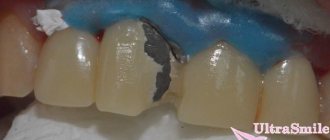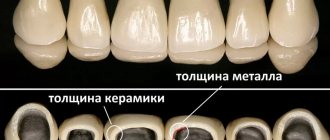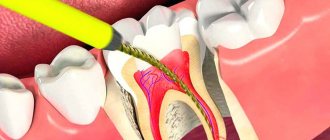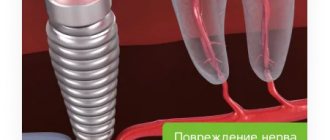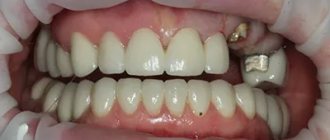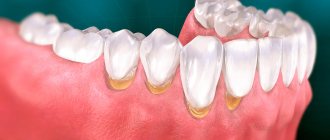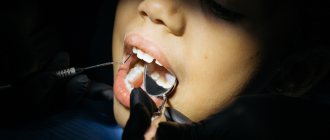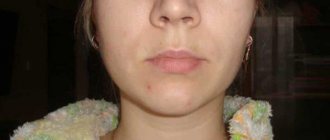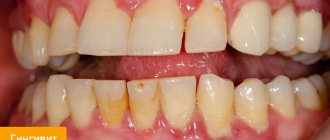In dental practice, there are often cases of advanced caries when a patient comes with complaints of acute toothache. If a doctor diagnoses pulpitis, then one of the stages of its treatment will be the installation of a temporary filling. It protects the canal from food and bacteria entering it. It should cover the exposed area of the tooth until treatment is completed by filling the canals and installing a permanent filling. In addition, the “temporary solution” is also relevant for a number of other pathologies.
Normally, the temporary “protection” is removed by the dentist. But there are situations when it falls out on its own. Why? Various factors can provoke this. But no matter what causes the temporary filling to fall out, it is important to know what to do in this situation and how to prevent complications from developing. After all, the consequences can be very unpleasant - from the spread of infection to the loss of a unit.
When is a temporary filling needed?
When a patient with caries comes to the dentist complaining of tooth pain, it is important for the doctor to assess how deeply the unit is affected and whether the roots and canals are affected. To do this, he sets up a “temporary station” for 2-3 days. If the nerve endings are damaged and a permanent filling is placed, the patient will again experience toothache and will have to have the tooth re-treated. A temporary filling will avoid unnecessary costs and stress.
The dentist decides to install temporary filling material if he diagnoses the patient with:
- deep caries;
- pulpitis;
- periodontitis;
- granuloma;
- tooth cyst;
- abscess.
Such dental manipulation is relevant if it is impossible to treat a tooth in one visit or you need to first relieve the inflammatory process. The doctor also places such a filling while the stump inlays or prostheses are being made in the laboratory.
Binge eating
This mistake is made by people who are not familiar with the structure of the digestive system. The only option when this solution can be partially correct is that the tooth is stuck at the end of the esophagus and you feel it somewhere above the stomach.
You can eat a small piece of black bread (white is more sticky), fruit or vegetable (preferably with a dense consistency). If after this the sensations do not change in any way, try again in half an hour. You can drink water.
In addition, a swallowed crown or other metal element of dental corrective structures will not be visible on an x-ray due to the large amount of food in the stomach and waste in the intestines.
How long is it temporary?
The period for installing such a filling depends on the purpose and clinical situation. It can range from 3 days to several months. If the doctor uses arsenic-based paste, then further treatment is carried out after 3-5 days, a maximum of a week. You cannot walk with arsenic in your tooth for any longer, as it can not only kill the nerve, but also destroy healthy tissue.
If the material used is necessary to protect against food and bacteria getting inside the canals during their sanitation or treatment of inflammation, it can remain in the tooth for several weeks. For longer treatments, the dentist may replace temporary fillings if a new dose of medication becomes necessary.
Treatment process
People faced with such a problem are interested in how the tooth will be treated when the filling has fallen out. It all depends on individual characteristics, so it is worth considering the most common situations.
If the carious cavity is too large, it makes no sense to fill it again. The material will not hold and will fall out again after a short time. Therefore, the doctor will suggest alternative methods of eliminating the defect, most likely installing a crown.
If repeated caries occurs, pulpitis or other diseases develop, they must first be cured. The doctor prescribes and carries out all the necessary measures and, after complete recovery, places a new filling. If the filling material falls out of a pulpless tooth, re-filling is often also ineffective. In this case, the specialist will recommend installing a pin.
Methods for restoring the integrity of a tooth depend on its condition, so it is difficult to suggest a treatment plan without a preliminary examination.
What causes a temporary filling to fall out?
A patient may have a temporary filling fall out due to medical negligence:
- if the doctor did not properly dry the tooth cavity after pre-treatment or saliva got there before applying the filling material;
- if, after cleaning the carious cavity, particles of infected tissue remain;
- if the surface is not processed well enough, which will cause the enamel to destroy the material;
- if the filling is placed on a pulpless tooth, in this case it cannot hold tightly, because the surface of the unit is fragile, nutrients do not reach it;
- if low-quality or expired materials were used to create a temporary filling;
- if the tooth is severely affected by caries and the filling does not have the necessary support.
But not only the doctor can be the culprit of the problem. A temporary filling falls out when the patient does not adhere to the recommendations received after dental procedures. For example, he decides to have a snack immediately after leaving the doctor's office. Despite the fact that you need to refrain from eating for 1-2 hours. In addition, the filling may fall out if there is a large load on it (when chewing nuts and candies, opening bottles with teeth, biting thread, etc.). Its gradual loosening is provoked by chewing gum and toffee candies, toffees.
Why do fillings fall out or do my teeth start to hurt again?
Primary treatment was poor or incorrect:
- The filling material was applied to an insufficiently dried crown. Because of this, the “connection” turned out to be unreliable, and the composite began to crumble or simply fell out;
- fragments of dental instruments or other foreign objects remain in the root canal, which provokes the development of infection;
- During filling, the root canals were not completely filled. This provoked the re-development of inflammation, the appearance of severe pain, swelling;
- filling material is of poor quality or improperly prepared. It shrinks too much when curing. Microcracks or gaps formed along the edges, causing the material to begin to deteriorate.
The filling broke due to the patient's fault:
- Due to poor hygiene, caries develops again. Without treatment, a previously installed filling may break or fall out;
- The filling material cracks, breaks, falls out due to too much chewing load (biting off hard foods, cracking nuts).
Natural reasons:
- The use of the filling material has expired and is destroyed due to wear;
- The tooth's own tissues are not hard enough.
Do you have questions about dental retreatment?
We will call you back within 30 seconds
+7
How can you tell if a filling is about to fall out?
After filling, the material occupies the entire drilled cavity; there are no gaps between it and the tooth tissues. When gaps appear between the filling and the tooth, it wobbles when pressed with the tongue, and you need to consult a doctor to prevent the material from falling out.
If this has already happened, and the patient notices a hole in the problem tooth, you need to act consciously. You cannot seal it with chewing gum or insert cotton wool or other improvised materials into the cavity. It will not be possible to seal the hole hermetically; such measures can only do harm, because this will create favorable conditions for the proliferation of pathogenic microorganisms and the spread of infection.
How does the composite filling procedure work?
Stages of the procedure for installing a composite filling:
- Patient anesthesia.
- Cleaning teeth from caries using special dental drills, and often under a microscope.
- Installation of a composite filling, which also takes place in several stages. First, the dentist applies a special gel to the tooth to prepare its surface for bonding with the composite. After washing off the gel, the cavity is dried and lubricated with another special liquid, the so-called bond, which is exposed to a polymerization lamp and hardens. On the base prepared in this way, the dentist places several layers of composite filling, which are irradiated each time for proper hardening.
- The final stage of treatment is to adjust the filling to the patient’s bite—grinding.
Correct installation of a composite filling is a guarantee of a beautiful smile. But most of all, it guarantees the patient’s health. The dentist must choose the right filling material that will match the structure of the tooth and its location in the oral cavity, thereby providing complete comfort to the patient.
What to do?
Of course, you need to see a dentist. But the patient does not always have the opportunity to urgently leave work. In addition, many people believe that there is nothing wrong with a filling falling out and are in no hurry to visit the dentist.
When the doctor places a filling, he notifies the patient about what materials are used and for how long it is installed. It is important to remember this, because if the doctor used arsenic-based paste to kill the nerves, then one should not hesitate in case of material loss. This substance is poisonous! If it gets on the mucous membrane, it causes a burn, and if swallowed, it causes poisoning, gastrointestinal upset, and the development of an allergic reaction.
Therefore, if the patient notices a hole in the tooth, he needs to thoroughly rinse the oral cavity with a soda solution (dissolve 1 teaspoon of soda in 1 glass of warm boiled water and add a few drops of iodine). After this, you need to cover the hole with a sterile gauze swab and go to the doctor.
If the dentist filled the canals and installed a temporary filling, but it fell out, this is not so dangerous. After all, there is no toxic substance inside the tooth and infection will no longer penetrate into the canals. But you still need to visit a dentist to solve the problem. The doctor will conduct an examination and decide what to do - put a temporary filling again or replace it with a permanent one.
We recommend remembering the following algorithm of actions:
- If the filling falls out while eating, it is better to spit out the chewed food. After this, you need to rinse your mouth with an antiseptic (Chlorhexidine, Miramistin) or a soda solution. If you don't have this on hand, you can use mouthwash or clean water.
- You should not try to close the hole with chewing gum or other improvised means, or pick out the remnants of the filling material. There is a risk of damaging the mucous membrane or leaving a piece of the used “tool” in the hole, which will provoke the development of the inflammatory process. Do not try to insert a painkiller or antibiotic tablet into the hole. It won't help.
- Before eating, it is necessary to cover the damaged unit with a sterile gauze pad and minimize the load on this side of the jaw. Be sure to rinse your mouth thoroughly after every meal.
- If pain bothers you, you can take a non-steroidal anti-inflammatory drug, for example, Nurofen, Trialgin, Ketanov, etc. The recommended duration of taking these medications without medical supervision is no more than 3 days.
- As a result, in any case, you need to make an appointment with the dentist and have your tooth treated.
It should be remembered that you should not put off visiting a doctor until later. This is fraught with the development of an inflammatory process and may lead to the need to remove the unit.
Consequences
In rare cases, swallowing the arc can cause such unpleasant consequences: the appearance of a hole in the esophagus, inflammation, decreased muscle tone, and even paralysis of the nerve endings in the lower region of the larynx. To avoid this, you need to visit a professional as soon as possible.
First of all, the person will definitely be sent for an X-ray examination, this will make it possible to understand in which part of the esophagus the arch fragment is stuck. Of course, in most cases the part comes out of the metal naturally. If this does not happen, the doctor may prescribe special medications with an enveloping effect.
It is important to understand that if you swallow an arc, you should not eat any food. This can only make the situation worse. Ingestion of any other part of the braces system is not dangerous, but it is always better to play it safe and visit a dental clinic for an examination. In any case, the broken part will have to be restored, since without it the treatment may not be effective.
Filling falling out during pregnancy
If a temporary filling falls out in a pregnant woman, it is also important to consult a specialist. If at the time of treatment she is in her third trimester, and a complex dental procedure is ahead, the doctor can install a new “temporary” and transfer the therapy to the postpartum period.
It is worth remembering that pregnancy is not a contraindication for visiting the dentist. On the contrary, it is better to visit this doctor more often to prevent the progression of caries. After all, this is a collection of microbes that can spread throughout the body and cause harm to health.
Inducing vomiting
Inducing vomiting is a very bad idea. If a tooth is stuck in the esophagus, this may not help, and getting it out of the stomach at the cost of dehydration and possible digestive upset is too costly in terms of the resources of the human body. It should be remembered that vomiting is an emergency defense mechanism, and not a normal state of the body. To cause it yourself means to consciously undermine your health.
Even if the tooth really got stuck on the way from the esophagus to the stomach, a sharp influx of semi-digested food from below will push it with enough force for the sharp edges to leave a scratch on the mucous membrane.
Prevention of temporary filling falling out
After the performed manipulations, the doctor always tells the patient what can and cannot be done after he leaves the office. And you need to follow these recommendations.
- You should not eat for 2 hours after filling. At this time, the material hardens.
- During the entire period while the temporary filling is in place, you must not chew nuts and other hard foods, eat chewing candies and other sticky sweets, or use chewing gum.
- It is recommended to minimize the load on the problematic tooth.
- Do not use a waterpik, toothpicks or dental floss to clean a temporary filling. The optimal hygiene product is a soft brush.
It is recommended to inspect the filling daily so that if defects appear, you can detect them in a timely manner and contact your dentist.
How dangerous is this?
A tooth is not a completely foreign body. This is a part of the victim’s body, which is also small and does not have serious dangerous properties such as toxicity. No human tooth is large enough to cause significant problems if it enters the stomach and esophagus.
It is very difficult to swallow the entire jaw
If you swallowed a tooth, you know about it, but you don’t feel it anywhere above your stomach, then there is nothing to worry about - it has already reached the center of the digestive system and will come out naturally over time. Danger occurs when a tooth gets stuck in the esophagus. It doesn’t matter whether it’s a solid tooth or a splinter, there is a high probability that it will have sharp edges. They are too small to seriously damage the mucous membrane of the throat, but they can cause panic and suffocation in sensitive people. It is not easy to push a tooth further out of the esophagus if it is stuck - those who have experienced such trouble associate their sensations with a fish bone stuck in the throat, only smaller.
Possible complications
When a temporary filling falls out, not all patients immediately consult a doctor. Some people don’t rush to the doctor until the tooth starts to hurt. And in vain, since the consequences can be extremely negative:
- spread of the inflammatory process due to the penetration of pathogenic microorganisms, which will require longer treatment;
- chipping of the crown, which will lead to the need for additional strengthening of the tooth;
- injury to the mucous membrane of the cheeks and tongue and, as a result, pain;
- the need to remove the unit.
How long does it take to walk with a hole? It's up to the patient to decide. But any dentist will tell you that you need to come for an appointment as soon as possible.
| Author of the article: | Gasparyan Eliza Arturovna |
| Speciality: | Dentist-therapist, dentist-endodontist |
| Experience: | 10 years |
Make an appointment
If a crown or filling is swallowed
Fillings with sharp edges carry the same potential danger to the esophageal mucosa as teeth, but they are much smaller in volume. Fillings may also not fall off completely, but rather break off into small fragments that pose almost no danger.
A swallowed crown will not cause any harm in itself, but you should visit the dentist as soon as possible to protect the remaining tooth without a crown.
The crowns are also small in size and if they get into the esophagus and further, they will not cause harm (except for possible micro-scratches). If a filling or crown falls out, you need to immediately fix this problem by installing a new one, even if the tooth does not hurt or bother you in any way. Open dental canals and healthy parts of the tooth will begin to deteriorate after a few weeks from eating food or hot liquids. Due to delay, there may be a need to completely re-treat the tooth.
Advantages of a composite filling
Composite fillings are valued by patients and dentists because they:
- fit tightly to the tooth tissue
- durable - very rarely damaged
- aesthetically pleasing - composite fillings perfectly match the shape and color of the tooth being restored, which gives it a natural appearance
- safe - composite is a material with high resistance to cracking and other damage. When forming it, the dentist does not have to remove a significant part of the healthy tooth tissue.
- inexpensive - the cost is at the average price level of dental procedures.
However, it is worth remembering that composite fillings can have their own disadvantages and are not suitable for large cavities.
